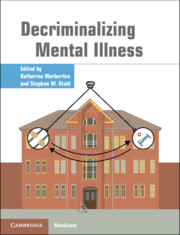Book contents
- Decriminalizing Mental Illness
- Decriminalizing Mental Illness
- Copyright page
- Contents
- Contributors
- Part I Introduction/Description of the Problem
- Part II Solutions
- Part III Psychopharmacological Treatment Considerations
- Chapter 18 Dopamine Antagonist Antipsychotics in Diverted Forensic Populations
- Chapter 19 Monitoring and Improving Antipsychotic Adherence in Outpatient Forensic Diversion Programs
- Chapter 20 Pharmacological Treatment of Violence in Schizophrenia
- Part IV Nonpsychopharmacological Treatment Considerations
- Part V Criminal Justice and Social Considerations
- Index
- References
Chapter 19 - Monitoring and Improving Antipsychotic Adherence in Outpatient Forensic Diversion Programs
from Part III - Psychopharmacological Treatment Considerations
Published online by Cambridge University Press: 19 October 2021
- Decriminalizing Mental Illness
- Decriminalizing Mental Illness
- Copyright page
- Contents
- Contributors
- Part I Introduction/Description of the Problem
- Part II Solutions
- Part III Psychopharmacological Treatment Considerations
- Chapter 18 Dopamine Antagonist Antipsychotics in Diverted Forensic Populations
- Chapter 19 Monitoring and Improving Antipsychotic Adherence in Outpatient Forensic Diversion Programs
- Chapter 20 Pharmacological Treatment of Violence in Schizophrenia
- Part IV Nonpsychopharmacological Treatment Considerations
- Part V Criminal Justice and Social Considerations
- Index
- References
Summary
California has the largest population of mentally ill defendants nationwide, and on June 27, 2018, the governor signed into law Assembly Bill 1810 that offered every county the opportunity to establish diversion program procedures (Section 15), and opened program access to all mental health diagnoses excluding antisocial personality disorder, borderline personality disorder, and pedophilia. This measure thus reflects the increasing nationwide interest in channeling seriously mentally ill individuals away from traditional legal processes into pre-trial diversion programs. On an individual level the goal is to provide treatment for mental health conditions, decrease the legal burden and consequences of arrest, and facilitate integration with community support structures.
- Type
- Chapter
- Information
- Decriminalizing Mental Illness , pp. 200 - 209Publisher: Cambridge University PressPrint publication year: 2021



